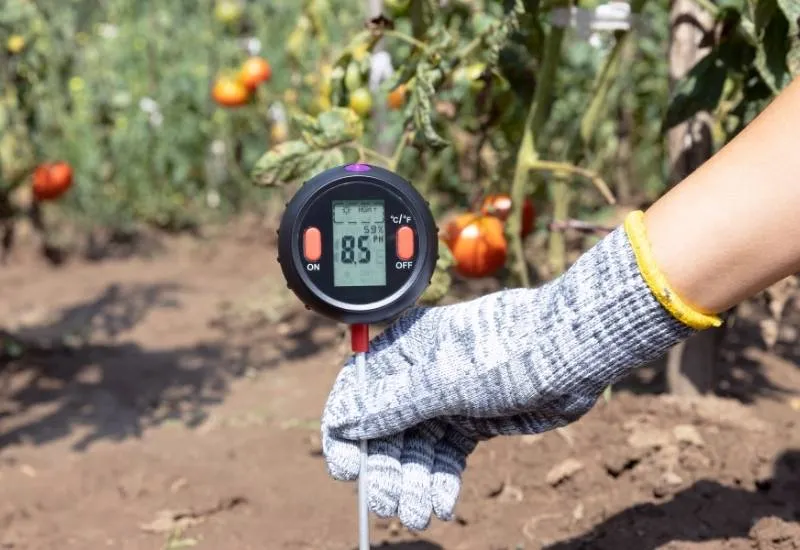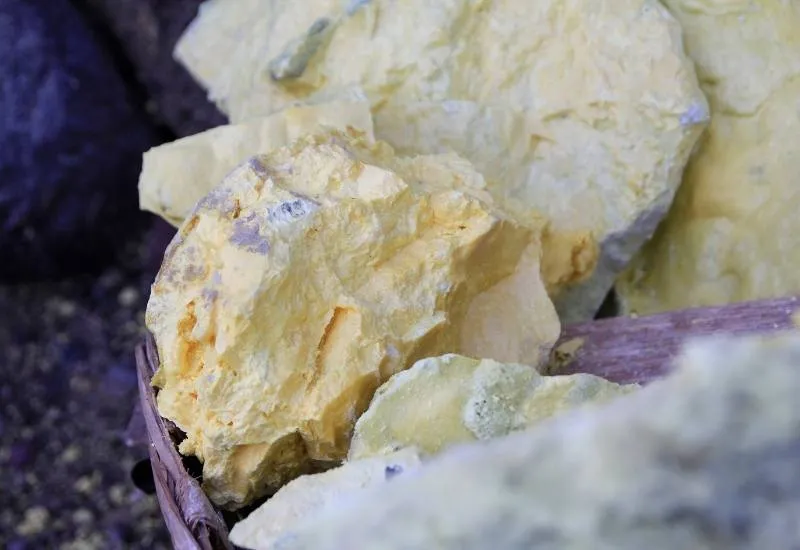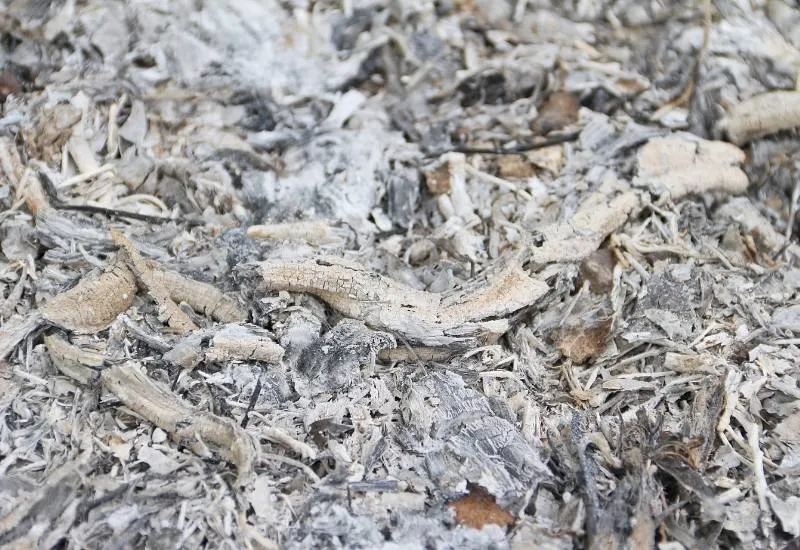Do tomatoes like acidic soil?

Have you ever wonder why your tomatoes flourish at times and suffer at others? One explanation might be the pH of your soil. Tomatoes are an acid-loving plant, thus having the appropriate soil acidity will have a significant influence on the performance of your tomato plants.
Tomatoes thrive on soils with a pH of 6.0 to 6.8. If your soil’s pH is too high, try adding sphagnum peat moss, sulfur, or chelated fertilizers to make soil more acidic.
To increase the pH of soil, use limestone, wood ash, and avoid using fresh pine needles. Adding compost will help balance your soil’s pH whether your garden is too acidic or too alkaline.
Continue reading to learn why tomatoes need acidic soil, how to test the pH of your garden soil, and how to change the pH of your soil to produce the ideal growth conditions for your tomatoes.
Contents
Are Tomatoes An Acid Loving Plant?

While producing tomatoes, the chemical makeup of your soil is critical, and this is assessed by the pH levels of your soil.
The pH level of your soil indicates whether it is acidic or alkaline and is measured on a scale of 0 to 14, with low values indicating acidic, high numbers indicating alkaline, and 7 indicating neutral.
Tomatoes are an acid-loving plant, which means they thrive in soils with a pH lower than 7.0.
The Ideal Soil pH For Tomatoes

Even though tomatoes appreciate acidic soil, the soil should not be excessively acidic. Tomatoes thrive in soil pH ranges of 6.0 to 6.8. However, they can go down to 5.5 and as high as 7.5 and still grow and bear successfully.
Why Do Tomatoes Need Acidic Soil?

The availability of some nutrients varies as the acidity of the soil changes. When the pH is either too high or too low, certain nutrients are not in a soluble form and cannot be used by the plants.
In the case of tomatoes, iron is an important mineral to consider since tomatoes have a high iron requirement. When the soil acidity is between 6.0 and 6.8, iron is easily accessible to the plant.
However, with a pH between 4.0 and 5.7, the still-present iron is no longer soluble and cannot be absorbed by the tomato plant. If the pH increases over 6.5, the iron remains there but becomes soil-bound, and your tomatoes may become iron-deficient.
This is true for many nutrients present in soil. When the pH of the soil ranges between 4.0 and 6.0, elements such as nitrogen, potassium, phosphorous, sulfur, calcium, and magnesium all become less available.
Reduced mineral absorption may result in stunted growth, poor fruiting, and illnesses that substantially decrease or kill your tomato plants.
Why Is It Important To Test My Soil’s pH?
There are several reasons to evaluate the pH of your soil. Iron insufficiency, for example, has symptoms with manganese deficiency and herbicide exposure. Hence, without a comprehensive soil test, it is impossible to identify what the problem is.
Measuring the pH of your soil eliminates much guessing and helps you to give the optimal soil conditions for your plants and produce the healthiest tomatoes.
How To Test The Acidity Of Your Soil

There are various methods for testing the pH of your soil. You and send a sample of your soil to a lab, purchase a kit to test your soil, or test your own soil with easy time-tested methods.
1: Send A Soil Sample To A Lab
Submitting a sample of your soil to a lab for testing is by far the most accurate and complete method, but it is also by far the most costly.
A laboratory will be able to test for more than simply pH (such as nutritional content and the presence of toxins), thus it is worthwhile to do so if you want a comprehensive examination of your soil.
Contact your local agricultural extension office, garden center, or landscaping firm to discover a lab that does soil testing.
2: Buy A Soil Testing Kit
Several different soil pH test kits are available on the market for a low price (less than $30) and may be fairly precise.
Digital readers with a little probe that you insert in the ground are available, as are kits with test tubes and small capsules to test the pH and other nutrients that your soil may be missing.
3: DIY Soil Testing Methods
If you are a do-it-yourselfer, here are two old-school “field tests” that farmers and gardeners have done for many years to evaluate the pH levels of their soil.
Technique #1: The first approach use litmus paper (also called pH test strips). You probably remember them from high school science class. Take a pinch of dirt from your garden and wet it with rainfall until it forms a ball.
Cut the ball in half, and squeeze a piece of litmus paper between the two halves. Wait a few minutes before inspecting the color of the paper. The paper will change colour depending on the acidity of the soil. Blue indicates alkalinity, whereas red indicates acidity.
Method #2. If you have a bottle of ammonia under your bathroom sink, you can use this to check the pH of your soil. With a glass of water, combine a spoonful of your soil.
Add a few drops of ammonia and mix everything together. After two hours, check the mixture. If the water is clear, the soil is alkaline; if it is black, the soil is acidic.
How To Make Soil More Acidic (Lower The pH)

If your soil is too alkaline (with a pH over 7.0), there are many ways to naturally make your soil more acidic so your acid-loving tomatoes will thrive. Here are a few strategies for lowering the pH of your soil:
1: Compost

Compost not only feeds your soil and plants by providing humus and important nutrients, but it also helps to balance the pH of your soil.
This implies that it will balance everything out by reducing pH levels that are too high and too low. Add lots of compost, or well-rotted manure to your garden every year and your plants will thank you.
2: Sphagnum Peat Moss

Peat moss is a slow-acting soil additive that provides organic matter while also improving water retention and aeration.
The pH of peat moss ranges from 3.0 to 4.5. Prior to planting, add 5cm to 8cm (2 to 3 inches) of peat moss and incorporate it into the top 30cm (12inches) of soil.
Peat moss should not be used as a top dress since it will fly away when dry and stiffen when wet.
3: Sulfur

Sulfur is a very common, fast-acting soil acidifier. Sulfur soil supplements are readily available in garden centres. (If your tomato plants need sulfur but your pH is already balanced, use Epsom salts).
When adding sulfur to your garden, be sure to follow the manufacturer’s instructions since too much sulfur may cause salt accumulation, which can harm plants.
4: Chelated Fertilizer
Chelated fertilizers are often used to help tomatoes grow in extremely alkaline soils because the chelated fertilizers provide iron that is otherwise tied up in the soil. Chelated fertilizers, on the other hand, should not be used to produce food and should be avoided for a variety of reasons.
First, chelated fertilizers do not fix an alkalinity issue, but are a band-aid quick-fix. Second, most chelated fertilizers include EDTA, a toxic chemical that has no place in our soil or food chain.
Finally, glyphosate is a prevalent chelating chemical that is a recognized carcinogen and causes a variety of other major health issues.
How To Make Soil Less Acidic (Increase The Ph)
Your soil may become too acidic for tomatoes at times. Acidic soil has an overabundance of hydrogen which dislodges other nutrients on the surface of soil particles.
These nutrients are thus either inaccessible to the plant or rinsed away by rains. (I am not a scientist so I apologize for the bastardization of this intricate chemical process).
If the pH of your soil is less than 5.5, here are some methods for raising it to the ideal range for tomato plants.
1: Compost

Compost, as previously said, will stabilize your soil’s pH levels and is the most natural approach to nourish and enhance your soil.
It is such a great soil amendment that it bears mentioning again. Fill your soil with as much compost or well-rotted manure as possible.
2: Limestone (Calcium)
The most frequent technique to reduce acidity or boost alkalinity in soil is to add calcium in the form of limestone. The limestone binds with the hydrogen in the acidic soil, creating calcium bicarbonate which is water-soluble and is naturally washed out of the soil.
Calcium offers additional advantages for tomatoes, such as avoiding blossom end rot. You may need to add calcium to the soil, but you DO NOT want to change the acidity. In this case, use calcium nitrate or gypsum to increase the calcium without affecting your soil’s pH.
How much limestone to add will depend on your soil’s current pH and what type of soil you have. Most lime containers provide application rates, so follow the manufacturer’s instructions.
3: Wood Ashes

Since they contain calcium carbonate, wood ashes are a natural approach to amend acidic soil. If you have a fireplace or burning barrel, wood ashes are also a very sustainable method to modify your soil.
They also provide potassium, phosphorus, and trace minerals, which are all extremely good for tomatoes. Don’t overdo wood ash applications, however, or it can make soil inhospitable: apply at a rate of 10kg (22lbs) per 100 sq meters (1,000 sq ft) every few years.
4: Remove Pine Needles
A growing body of information demonstrates that pine needles have little effect on soil pH surrounding trees. In fact, pine needles that have been dried or composted are often used as mulch with great success.
Yet, since fresh pine needles are quite acidic (3.2 to 3.8), they may cause the soil to be acidic, but not considerably.
If your soil is really acidic and you are attempting to neutralize it, it is usually best to avoid using fresh green pine needles.
Raising tomatoes can be a sensitive business, and controlling the pH of your soil is an excellent approach to ensure a perfect growth environment for these garden mainstays.
Adding compost offers so many general advantages for your garden that it bears repeating, but I hope this article has given you a few more suggestions to help you modify your garden to produce the healthiest, best-tasting tomatoes possible.
Related Questions
-
Is acidic soil good for tomatoes?
Most vegetables thrive on soil that is somewhat acidic, with a pH between 6.0 and 7.0. Experiments show tomato plants grown at pH 4.8 are undersized, but normal at pH 6.0. Corn yields are 66 percent lower at pH 4.7 than at pH 6.8.
-
How acidic should soil be for tomato plant?
Tomatoes need soil pH levels ranging from 6.2 to 6.8.
-
Can tomatoes grow in alkaline soil?
Tomato plants like soil that is somewhat acidic, with a pH of 6.0 to 6.5. If your soil is too acidic (low pH) or too alkaline (high pH), nutrients become less available, which slows tomato plant growth.
-
Are eggshells good for tomato plants?
Crushed egg shells are high in nutrients. Nutrients that can both energize your tomato plants, and protect them from blossom end rot.





